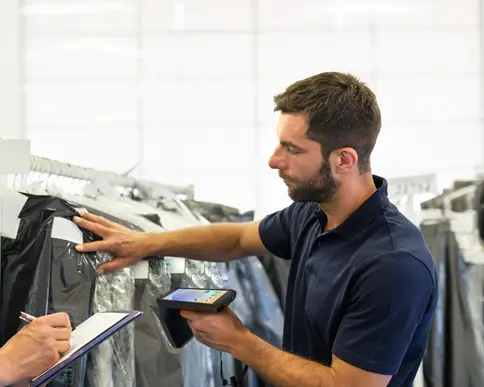Brief Introduction
The rapid development of the Internet has given rise to the increasing complexity and diversification of supply chains, and logistics and warehousing are also facing enormous challenges. How to achieve digital management of supply chain warehousing has become a focus of attention for many enterprises.
We have launched two different data collection solutions for different on-site requirements of supply chain warehousing. Let's take a look together!

Option 1: RFID Reader for Warehouse Cargo Management and Tracking Solution
RFID reader is an application of wireless communication technology, which can identify, read, and write items embedded with RFID chips, achieving efficient management and tracking of logistics business. The application of RFID readers in supply chain warehousing can bring the following significant advantages.
1. RFID readers can achieve warehouse management of goods. Traditional warehouse management requires manual recording, inventory, and inquiry, which is time-consuming and prone to errors. RFID readers can perceive and read information on goods labels in real time, and achieve automated management of goods through seamless connection with warehouse management systems. This not only improves work efficiency, but also reduces errors caused by human factors, greatly enhancing the precision management level of supply chain warehousing.
2. RFID readers can also achieve traceability management of goods. In a complex and diverse supply chain environment, traceability of goods is essential. By adding RFID chips to the goods label, production information, flow trajectory, temperature and humidity of the goods can be recorded. When problems arise, RFID readers can accurately trace the source and process of the problematic goods, which helps improve the quality management and risk control capabilities of the supply chain.
3. RFID readers can also monitor and maintain storage equipment. Traditional equipment monitoring and maintenance often rely on manual inspections and sampling inspections, which are inefficient and not precise enough. RFID readers can connect with devices, obtain real-time operational status and maintenance information, and help enterprises detect faults and repair them in a timely manner. This not only improves the reliability of the equipment, but also reduces maintenance costs, providing strong support for the normal operation of supply chain warehousing.
Option 2: Industrial Tablet Onboard Solution
AUTOID Pad Air industrial tablets are widely used in the warehousing industry. Assist customers with paperless operations and intelligent operation throughout the entire process, making frontline staff more worry free and efficient in their work.
1. The intelligent forklift application in the warehouse, AUTOID Pad Air industrial tablet computer, can be firmly fixed in the forklift through bracket accessories, ensuring stable and safe driving; Durable and long-lasting design, reducing equipment repair rates. The operators use forklifts to transport goods while also carrying out intelligent system processing on the forklifts, greatly improving work efficiency.
2. The AUTOID Pad Air industrial tablet computer has multiple collection capabilities, strong scanning performance, and can scan Code128 barcodes as small as 3mil for professional decoding, making it easy to recognize various difficult to read barcodes such as DPM, oil stains, thin films, and bends; Equipped with photography function, it meets the needs of taking photos and keeping samples in homework scenes.- The Critical Role of Mobile Computers in Warehouse Logistics2025-06-25
- Seuic Mobile Computers: Multi-Scenario Efficiency Solutions2025-06-24
- Operation Guide and Industry Applications of Seuic Mobile Computers2025-06-23
- How to Choose Mobile Computers for Your Industry Needs2025-06-20
- Mobile Computers: The All-in-One Tool from Data Collection to Industry Implementation2025-06-19